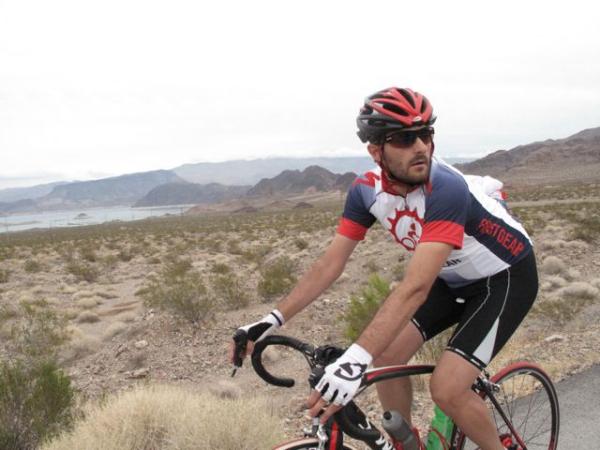Morkov and Sabatini: The art of the lead out
Viviani's trusted train on what it takes to be lead-out riders
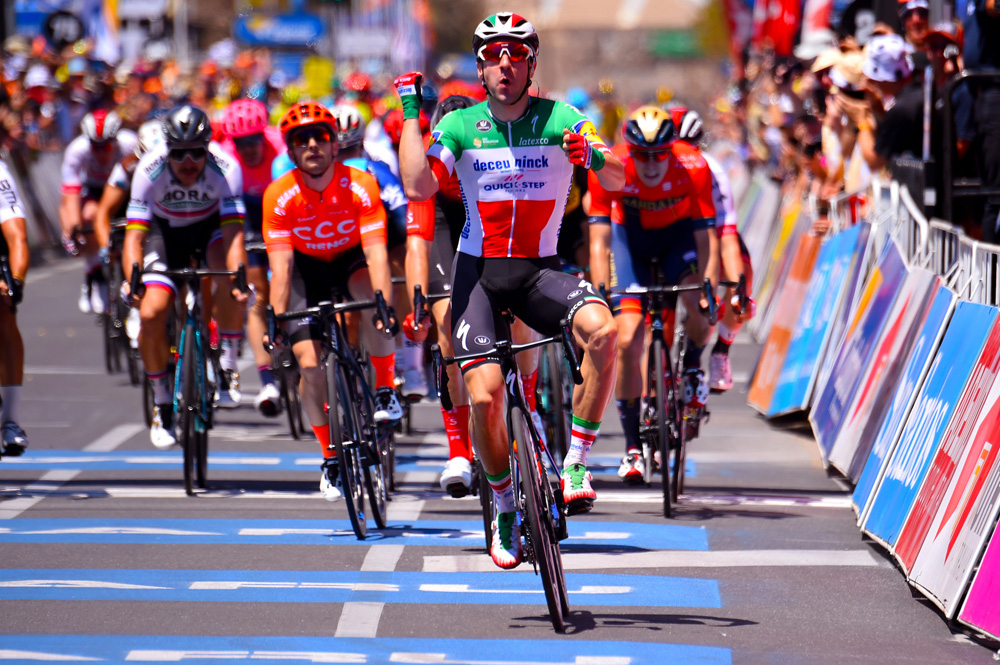
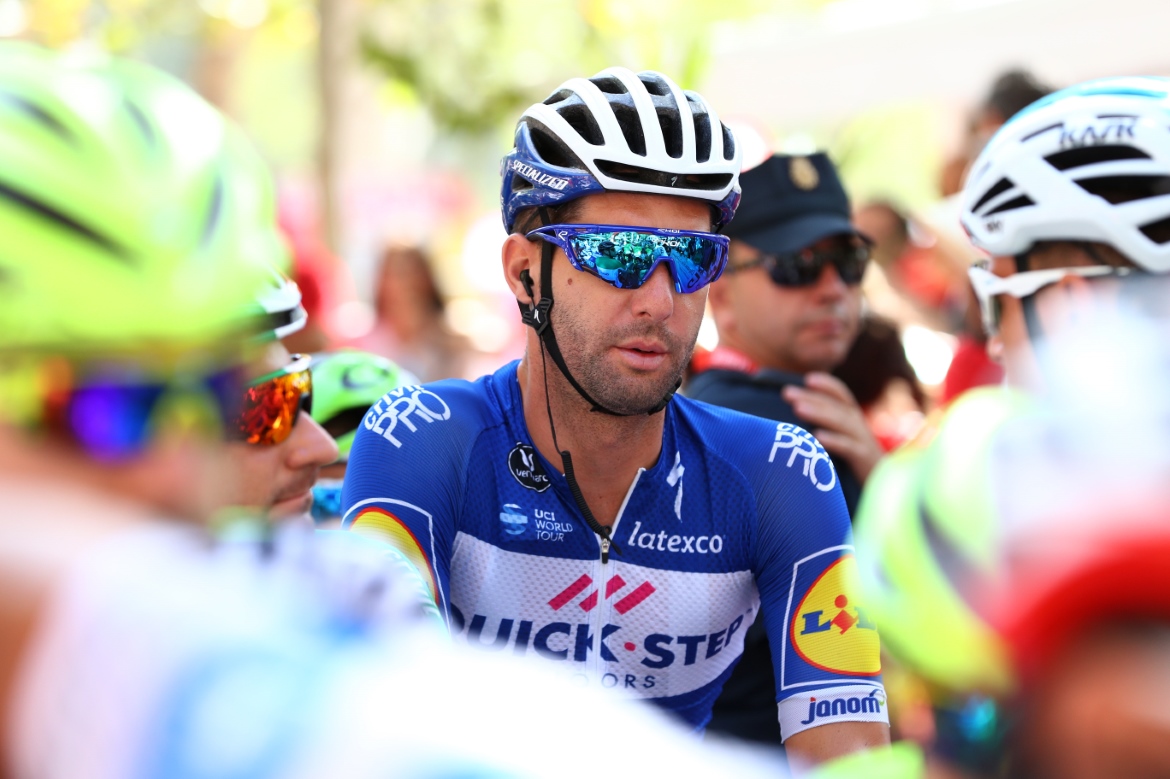
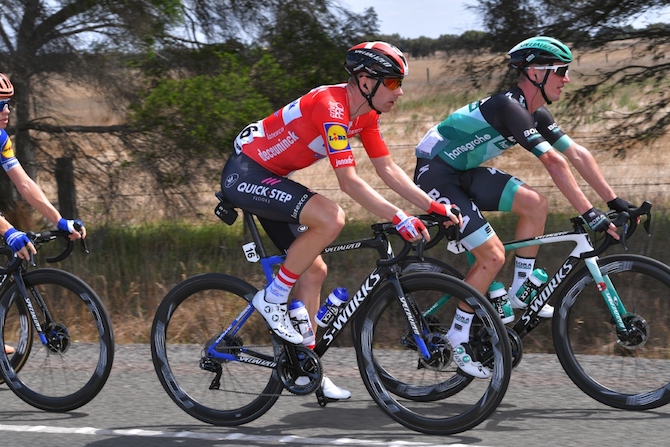
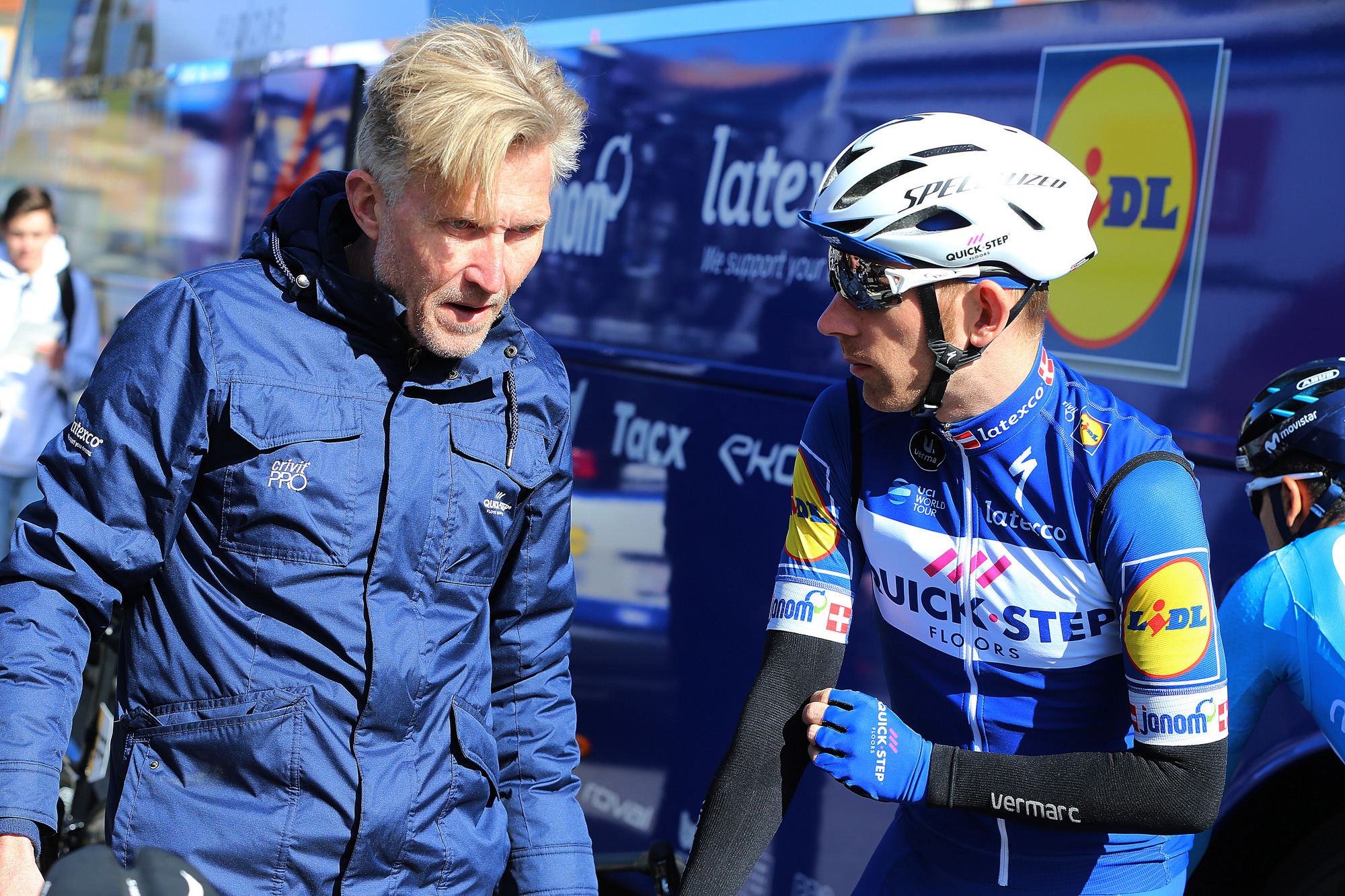
Fabio Sabatini and Michael Mørkøv are both experienced riders when it comes to perfecting a lead out. They are currently the final two men in the train for Deceuninck-QuickStep's Elia Viviani, one of the best sprinters on the planet.
Sabatini has ridden as a lead-out man for many successful sprinters such as Erik Zabel and Alessandro Pettachi, while Mørkøv comes from a track background after winning silver in the Team Pursuit at the 2008 Beijing Olympic Games. They are experience personified, having competed in a combined number of 29 Grand Tours, and they are two of the most seasoned riders in the peloton.
In a traditional lead out for Viviani, Sabatini is sheltered by Mørkøv until the final 400-500m before he's handed the reins for the final burst before Viviani is left on his own to finish the job. Last season, Viviani picked up 18 victories during the road season with the help of Sabatini and Mørkøv, and during January's Tour Down Under, the pair took the time to give Cyclingnews an insight into what makes the perfect lead out.
Cyclingnews: Fabio, when you started your career was it always with the intention of becoming a lead-out rider?
Fabio Sabatini: I started with Alessandro Petacchi and Erik Zabel at Milram in 2006, where the training was really different because the team was completely for Petacchi so my work and that of my teammates was all about working towards the lead-out. Like I said, we had Zabel but also riders like Fabio Sacchi, so I learned a lot from them, and of course from Alessandro.
CN: Michael, who did you learn from the early years of your career because you came through the ranks with a slightly different set-up?
Michael Mørkøv: I came into the WorldTour a few years later with Saxo Bank in 2009. With Saxo they never really had a big tradition for sprints. We had JJ Haedo but he normally managed himself. I turned pro with them because I was a Danish rider but in my first year I was never really a part of the sprint lead-out during that phase. That came later.
Get The Leadout Newsletter
The latest race content, interviews, features, reviews and expert buying guides, direct to your inbox!
During my years at Saxo, we never really worked on sprints, but obviously over the years I learnt that I could be good for this kind of work. Then, when my contract at Saxo was running down, I got the opportunity to go to Katusha with Alexander Kristoff who needed a guy in the sprints for him. And from that point, in 2016, I started to become more of a lead-out man in the peloton.
CN: How specific is the role? Is there a certain skillset that you need?
MM: In the pro peloton there are some guys who are just lead-out men and then you have some guys who are more all-rounders. Or even in some cases you can have sprinters themselves who lead out. But I would say there are some skills you need to become a lead-out man.
You need to have the ability to really accelerate; you need to be able to produce a high power; you need to be aerodynamic on your bike; and you need the skills to guide your sprinter in the peloton. For me and Fabio, we also have a lot of experience. Bunch sprints can be completely different from the Tour Down Under, to the Tour de France, to Paris-Nice. So, experience is very important also.
FS: Also, you need to have that 'feeling' and like Michael says that's about experience. Last year, the first race here for me and Michael was difficult. But after that racing with each other became easy.
CN: Do the skills change the further you move down the lead-out?
MM: The skills change dependent on your position within the train because the demands are different for each rider. We play around a lot with different tactics and different approaches to the sprints, and I think that is one of our strongest characteristics; that we are flexible and do different variations of lead-out.
So, in a really classic lead-out we'll probably have a teammate in front of me, then I will be starting 700-800m out, bring Fabio to 400m and then Elia from 200m.
Then we have situations like the other day [stage 1 of the Tour Down Under -ed] when our goal was to bring Elia to a good position with the other sprinters because we had a headwind so we didn't want to go to the front too soon. For that, we used Fabio's experience more to guide Elia through the peloton and I was acting as a back-up in case they needed to move up faster than anticipated.
But sometimes it's about drafting around in the peloton and finding other teams to play on.
CN: What is the most complicated part of a lead-out?
FS: The most difficult part of a lead-out is finding a good position coming into the final kilometre, because normally by the time you reach the final kilometre the sprint is already done.
Also, when the road is a little uphill it's important to hold and wait which is not easy for me and Michael as lead-out men. It is easier when it is flat. The riders change position a lot more when it is uphill, so it is a more difficult situation to manage.
MM: The hardest part is the timing because it's all about trying to arrive in the best possible position in the last kilometre. When you arrive in the position you want everything to go automatically. I know where I should start, Fabio knows how he should accelerate for Elia and swing off at the right speed.
CN: What's the optimum number of men for a lead-out? Do you always need six or seven riders around a sprinter or do you need just one?
FS: When I was riding for Milram and Petacchi the team at the Giro d'Italia it was completely for him. The team was nine riders, all for him, and when you have five or six riders for a lead-out it is easy. Now there is too much importance on the general classification so it is not like 10 years ago.
MM: So, what works for us is to have me and Fabio as the lead-out guys for Elia, then often in the race we have one or two guys who get us towards the sprint. But basically, the lead-out is just me and Fabio so we are very flexible.
Also, if you want to be lined up with five or six guys it's very difficult to change your plan if you suddenly want to stay on the left or something like that. With three of us it is very easy to change position and follow the tactics of how the other teams are racing.
CN: Other than a crash what's the one thing that can derail a sprint train more than anything else?
MM: There are many things that can fuck up a lead-out. It can be bad timing, you see it when a team arrives at the front too early and they leave their sprinter in front for no reason.
FS: You see that a lot. Sometimes when we see teams pushing for seven or eight kilometres, Michael will hold back and then in a second move myself and Elia towards the front when it's time.
CN: What tricks of the trade are there once you know your sprinter really well? For example, I remember one rider telling me that HTC couldn't see Mark Cavendish because he was small, so he'd wear really long socks so his teammates could see where he was in the peloton. Are there other things riders do to help their lead-out men out?
MM: Elia stays in the wheel really well, we never normally lose him, do we?
FS: That's because he's from the track so it's much easier with him than with other riders like Marcel Kittel. Riding with Kittel two years ago, he's really strong, has a lot of power, but sometimes I'd lose him. Elia is from the track so he can change positions very quickly.
MM: Sometimes it can be difficult for a sprinter because if he wins a stage he gets another jersey to wear, but now for example, Elia is wearing the Italian national champion's jersey. So, when you look behind for a split second it's easy to spot him.
CN: How much communication can there be with less than a kilometre to go?
MM: We always help each other because what I see can be very different from what Fabio sees. So, if he sees a few teams arriving he will say I need to move or if Elia is a bit boxed in he will tell us to move. But you can't have too much conversation, obviously.
CN: Do you have a set number of instructions?
FS: We have confidence in each other. We can say go, wait, left, right, basic instructions.
CN: Do you look at other teams or do you just not let that disrupt your lead-out train?
FS: We have to make sure we know what is going on with the other teams, when they are moving.
MM: That is a really important part. A big part of the sprint is to analyse what the other teams are doing, play on them and playing on their mistakes. We are really carefully watching the other teams and then we take the opportunities that we get.
CN: Do you have to be a sprinter to be a lead-out man?
MM: To be the last lead-out man I would say you need to be sprinter because you need to be able to reach a really high speed. But to be in my position, in front of Fabio, you don't need to be super fast. What you need more of is to have a high-power output for 30 seconds to a minute, do a strong pull more than a sprint.
CN: Do you ever switch roles?
MM: We stay flexible. If I don't feel good or Fabio doesn't feel good we change the set-up a little bit. Also, it depends on the stage and how Elia wants to be delivered. We can analyse some sprints where it is more important that I reach I really high speed, more than just a long progression. I could even take the lead-out with one kilometre to go and keep him in a good position. So, it can be quite different.
CN: How do use other lead-outs from the peloton? You often see very organised trains but then when you go to other races you see guys who aren't sprinters and they're in the way. How do you navigate that?
MM: When you go to the biggest races like the Tour de France it's easy. If you do the biggest races then you know the other teams' components, their lead-outs, you also have an idea of the tactic they're going to do.
FS: We raced a lot against Lotto with Greipel. He always had Sieberg and these guys around him and they had a certain way of doing the lead-out. So, often we would look to them and stay close to them. But then again you have smaller races where you have one team and then a lot of younger guys which makes it more chaotic and difficult to understand.
CN: Does it matter if there is a break up the road? Does that change the lead-out?
MM: If a guy is up the road in the break or something it doesn't really change the dynamic. We trust they guys who pull before us because they have the responsibility to pull back the breakaway. And we focus on timing our sprint.
FS: It's also really important at what time there is the lead-out. If you catch the breakaway 20 or 30km before the sprint another breakaway may go. So, it is better to close the gap in the last 10 or 15 kilometres.
CN: How much work do you have to do with your sprinter before you get to the lead-out?
MM: On the sprint days we will save Elia, me and Fabio during the race so we don't do too much heavy work because the lead-out is as important as the sprint by Elia. So, we need to be fresh. It depends how the team is but we often have some lighter riders, climbers, who help us with getting food and drink on the flat stages and then on the mountainous stages me and Fabio will be helping them more on the climbs.
CN: How well do you need to know your opposition?
MM: We know who are some of the best lead-out men in the other teams and we also know some of the guys who try to go long for the lead-out, some hide a bit more, it all happens in such a short period of time so you need to look what's happening. Sometimes we lose because we don't know the finish.
CN: How much analysis can you do for the route?
FS: In the Giro we don't see the final kilometres, only through websites and Google maps. It is different here [at the Tour Down Under] because we go training and see the final kilometres.
But there are many times when you're racing finishes for the first time in your life at 65kph and have to do the perfect lead-out. So, you try to find some pictures the day before on the computer to see if there is a roundabout before the last corner, how wide the roads will be, but you can always be surprised. It happens when you think the last corner is at 800m, but it is actually only 600m and that can be a big difference in terms of the lead-out.
CN: What do you do if you lose your sprinter? Is there anything you can do?
MM: You can't really do much if you lose your sprinter, and if you do then you just need to wait for him to come back.
FS: It's really important to stay calm. Me and Michael stay calm.
MM: No panic.
Daniel Benson was the Editor in Chief at Cyclingnews.com between 2008 and 2022. Based in the UK, he joined the Cyclingnews team in 2008 as the site's first UK-based Managing Editor. In that time, he reported on over a dozen editions of the Tour de France, several World Championships, the Tour Down Under, Spring Classics, and the London 2012 Olympic Games. With the help of the excellent editorial team, he ran the coverage on Cyclingnews and has interviewed leading figures in the sport including UCI Presidents and Tour de France winners.
